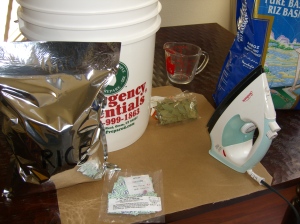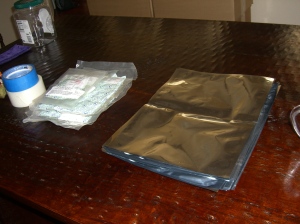After shopping around for bulk survival food https://apartmentprepper.wordpress.com/2010/11/04/survival-food-shopping/ and storage materials, https://apartmentprepper.wordpress.com/2010/11/13/items-needed-for-storing-survival-food/ I am finally ready to start storing.
First, I gathered up all my supplies on the dining table:
- Food items such as rice, pasta, pinto beans, etc.
- 5 gallon food grade buckets
- 1 gallon size mylar bags
- oxygen absorbers (300 cc)
- measuring cup
- iron
- masking tape and sharpie marker for labeling
- cardboard to place over the table (under the iron)
- airtight jar to keep extra oxygen absorbers
- bay leaves to ward against weevils
The photo shows the mylar bags, oxygen absorbers, masking tape and jar.
- A few things to note: Before you start, set the iron to the hottest setting. Make sure you set the iron on a covered surface to avoid burning. I used recycled cardboard from a large pizza box, but you should determine what works best for you.
- While these steps are doable with one person, it is easier to do them with two people, so you have someone holding the bag while the other person is ironing across. My husband helped me out on this so it went a bit faster.
- You will need to set aside a solid block of time to do this: Oxygen absorbers start activating as soon as you open the package. If you have to stop and leave them for later, you must store them in an airtight container or they will become useless.
- DO NOT use oxygen absorbers for storing sugar. This will cause the sugar to harden into a block.
We did the following to steps:
- Place one oxygen absorber in the bottom of the mylar bag.
- Pour 12 cups of rice (or whatever you are storing) into the bag. I used a 2 cup measuring cup to as this was quicker than doing it one by one.
- Add another oxygen absorber and one bay leaf on top of the rice. There should be about an inch clearance from the top edge of the bag to where the rice fills up to.
- Line up the sides and across the top of the mylar bag flat.
- Carefully iron across the top, leaving a 1 inch space open on the left corner. Don’t worry, the iron will not stick to the mylar, it actually stays smooth. Do not try to make a fold across the top and iron it: we tried this and it does not seal as well.
- “Burp” the bag to let any remaining air out.
- Now you can iron the remaining space and seal it up. Careful, as the iron can get too hot. About an hour after we started, we noticed the bags were not sealing as well, then we realized the iron had gotten too hot and the automatic shut off activated. Make sure your iron does not overheat.
- Label the bag with a sharpie pen.
- Place the mylar bag in the food grade 5 gallon bucket.
- Keep packaging the same food item into mylar bags following the above steps until the bucket is full.
- Seal up the bucket.
- Label the bucket. I used a masking tape and wrote the contents of the bucket with a sharpie market.
- Store any remaining oxygen absorbers in an airtight jar.
- Store the bucket in a cool, dry area. I cannot store food in the garage as we live in a hot and humid area. Heat and humidity will shorten the life of stored food. For now, the buckets are hidden under the dining table with a long table cloth.
 The next day, you will notice the bags look shrunken. This is the oxygen absorber doing its job.
The next day, you will notice the bags look shrunken. This is the oxygen absorber doing its job.
That’s it, the process was actually easier than I thought.

